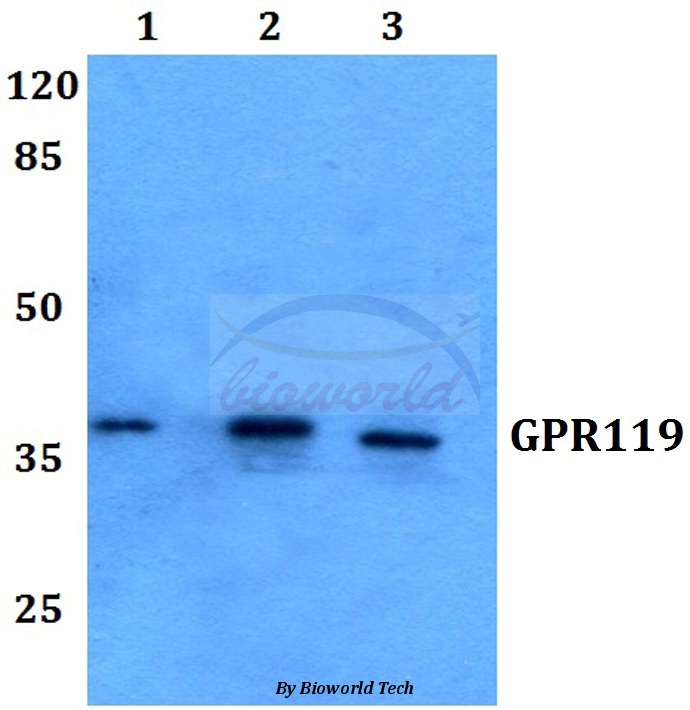Product Name :
GPR119 (V227) polyclonal antibody Background :
G protein-coupled receptors (GPRs) are a protein family of transmembrane receptors that transmit an extracellular signal (ligand binding) into an intra cellular signal (G protein activation). GPR signaling is an evolutionarily ancient mechanism used by all eukaryotes to sense environmental stimuli and mediate cell-cell communication. All of the receptors have seven membrane- spanning domains and the extracellular parts of the receptor can be glycosylated. These extracellular loops also contain two highly conserved cysteine residues which create disulfide bonds to stabilize the receptor structure. GPR119 is a 335 amino acid protein that is mainly expressed in the pancreas. It is an endogenous receptor for lysophosphatidylcholine (LPC), which is is a lipid mediator involved in insulin secretion from pancreatic cells. GPR119 may participate in this insulin secretion, suggesting that it may be potential target for new anti-diabetic drugs. Product :
Rabbit IgG, 1mg/ml in PBS with 0.02% sodium azide, 50% glycerol, pH7.2 Storage&Stability :
Store at 4°C short term. Aliquot and store at -20°C long term. Avoid freeze-thaw cycles. Specificity :
GPR119 (V227) polyclonal antibody detects endogenous levels of GPR119 protein. Immunogen :
Synthetic peptide, corresponding to amino acids 190-240 of Human GPR119. Conjugate :
Unconjugated Modification :
Unmodification
GPR119 (V227) polyclonal antibody Background :
G protein-coupled receptors (GPRs) are a protein family of transmembrane receptors that transmit an extracellular signal (ligand binding) into an intra cellular signal (G protein activation). GPR signaling is an evolutionarily ancient mechanism used by all eukaryotes to sense environmental stimuli and mediate cell-cell communication. All of the receptors have seven membrane- spanning domains and the extracellular parts of the receptor can be glycosylated. These extracellular loops also contain two highly conserved cysteine residues which create disulfide bonds to stabilize the receptor structure. GPR119 is a 335 amino acid protein that is mainly expressed in the pancreas. It is an endogenous receptor for lysophosphatidylcholine (LPC), which is is a lipid mediator involved in insulin secretion from pancreatic cells. GPR119 may participate in this insulin secretion, suggesting that it may be potential target for new anti-diabetic drugs. Product :
Rabbit IgG, 1mg/ml in PBS with 0.02% sodium azide, 50% glycerol, pH7.2 Storage&Stability :
Store at 4°C short term. Aliquot and store at -20°C long term. Avoid freeze-thaw cycles. Specificity :
GPR119 (V227) polyclonal antibody detects endogenous levels of GPR119 protein. Immunogen :
Synthetic peptide, corresponding to amino acids 190-240 of Human GPR119. Conjugate :
Unconjugated Modification :
Unmodification
Bioworld Biotech only provide peptides for our antibodies and do not provide additional peptide customization services.
Price/Size :
USD 368/1mg/vial
Tips:
For phospho antibody, we provide phospho peptide(0.5mg) and non-phospho peptide(0.5mg).Describe :
Blocking peptides are peptides that bind specifically to the target antibody and block antibody binding. These peptide usually contains the epitope recognized by the antibody. Antibodies bound to the blocking peptide no longer bind to the epitope on the target protein. This mechanism is useful when non-specific binding is an issue, for example, in Western blotting (WB) and Immunohistochemistry (IHC). By comparing the staining from the blocked antibody versus the antibody alone, one can see which staining is specific; Specific binding will be absent from the western blot or IHC performed with the neutralized antibody.Formula:
Synthetic peptide was lyophilized with 100% acetonitrile and is supplied as a powder. Reconstitute with 0.1 ml DI water for a final concentration of 10 mg/ml.The purity is >90%,tested by HPLC and MS.
Storage:
The freeze-dried powder is more stable. For short time at 2-8°C. For long term storage store at -20°C.
Note :
This product is for research use only (RUO only). Not for use in diagnostic or therapeutic procedures.
 GPR119 (V227) polyclonal antibody
GPR119 (V227) polyclonal antibody 
 Datasheet
Datasheet COA
COA MSDS
MSDS SHIP
SHIP